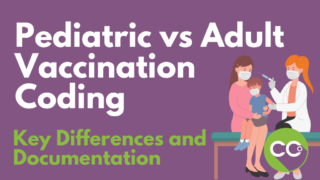
Vaccination coding can be complex, with frequent updates to guidelines and nuances between pediatric and adult immunizations. In this in-depth article, we’ll explore key considerations, documentation requirements, and examples to master vaccination coding for patients of any age.
Key Factors When Coding Vaccinations
Let’s first run through some key factors to keep in mind when coding for vaccinations:
Pediatric Codes
- Pediatric vaccination codes are age-specific, with the patient’s age range called out in the code description. This allows accurate code selection based on the recommended schedule.
- Vaccines are often given in a series, requiring knowledge of the schedule, intervals, and combination status. For example, a vaccine may involve 3 doses spaced out over several months.
- Combination vaccines with multiple antigens require understanding each component to select the right code.
- Vaccine administration usually involves counseling. Some codes include couseling in the description.
- Incomplete vaccinations must be accurately captured to reflect true status.
Adult Codes
- Adult vaccination codes are age-neutral – the patient’s age doesn’t factor into code selection.
- The vaccine type is the emphasis. Understanding exactly which vaccine was given allows accurate code selection.
- “High risk” codes may apply if the patient has conditions making them more vulnerable.
- Booster shots and revaccination are common and have designated codes.
- Travel vaccinations are tied to specific regions and the risks involved.
Pediatric Vaccination Coding
Let’s look closer at some key aspects of pediatric vaccination coding:
- Age-Specific Codes: Pediatric CPT codes specify the recommended age range for each vaccine. This allows coders to accurately reflect administration based on published schedules. For example, code 90633 is for a hepatitis A vaccine, pediatric/adolescent dosage, 2 dose schedule, for intramuscular use. The 2 dose schedule is recommended between the ages of 12-23 months.
- Vaccine Series: Pediatric vaccinations often involve a series of doses over time. Coders must understand the schedule to select the right code. For example, DTaP is given at 2 months, 4 months, 6 months, etc. Code selection depends on where the patient is at in the series.
- Combination Vaccines: Many pediatric vaccines combine multiple antigen components (e.g. MMR, DTaP). Coders need to know the composition to assign the correct code. Counseling and consent is required for each component.
- Incomplete Vaccinations: Documentation must capture incomplete vaccination status if a child misses doses. This ensures accurate coding and proper follow-up.
- Counseling: Vaccine administration usually includes counseling. Topics include risks, benefits, side effects, and disease prevention for each component.
Adult Vaccination Coding
Adult vaccination coding differs in the following ways:
- Age-Neutral Codes: Adult vaccine codes don’t specify age ranges, since scheduling is not age-dependent. This simplifies code selection.
- Vaccine Type: The vaccine name is the key factor, rather than age. Understanding the exact vaccine given based on documentation allows accurate code selection.
- High-Risk Codes: Patients with conditions like diabetes or immunosuppression may require special vaccine types, reflected in “high risk” codes.
- Boosters: Adults often require booster doses of vaccines. CPT includes designated codes for subsequent inoculations.
- Travel: Adults receiving travel vaccinations are assigned codes based on their destination and associated risk.
Key Components of Vaccination Coding
Accurate vaccine coding relies on detailed documentation containing:
- Vaccine name, volume, and all ingredient components
- Route of administration (e.g. intramuscular, subcutaneous)
- Specific anatomical injection site
- Vaccination date, time, dosage, and lot number
- Any adverse reactions
Two main code types are required:
- Vaccine Codes: Representing the antigen itself. Selected based on the vaccine name, type, volume, and components.
- Administration Codes: Representing the injection, or “stick.” Selected based on route, number of components, and patient age.
Examples
Pediatric DTaP-IPV-Hib + HepB vaccines + counseling
- 90721 (DTaP-IPV-Hib)
- 90744 (HepB pediatric)
- 90460 (1st vaccine administration)
- 90461 x2 (additional components)
- 99401 (counseling, 15 minutes
Adult Twinrix (HepA-HepB) vaccine
- 90636 (Twinrix adult dosage)
- 90471 (1 vaccine administration)
Conclusion
While vaccination coding can be complex, understanding key documentation elements, code types, and guidelines allows accurate representation of immunizations. Code selection relies on vaccine components, schedule details, age specifications, and administration route – mapped precisely to medical record details. Mastering these key factors is crucial to proper vaccination coding, reimbursement, and supporting public health tracking.
![[CCO] Certification Coaching Organization LLC [CCO] Certification Coaching Organization LLC](https://www.cco.us/wp-content/uploads/2015/05/CCO-Logo-2015-d3-500px.png)

Hi Alicia & Laureen! Vaccine coding IS complex. I don’t think I agree with your Peds example though. 2 vax injections with counseling should be 90460 x 2 (1st or only component of EACH vaccine), 90461×2. I would not code the 99401 unless additional counseling was documented. 90460/90461 include counseling.
I see what you are saying and you have a good eye. However the counseling in this case is for the other vaccines given that day. You are right, 90460 & the add on code 90461 have counseling included. 90721 & 90744 do not.